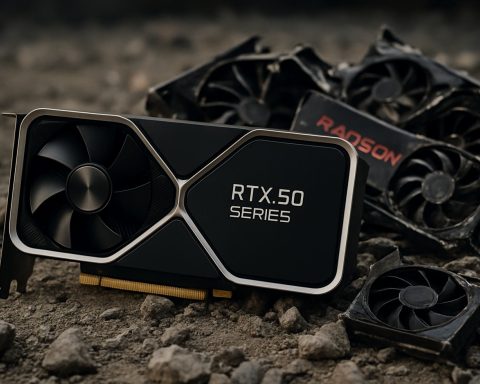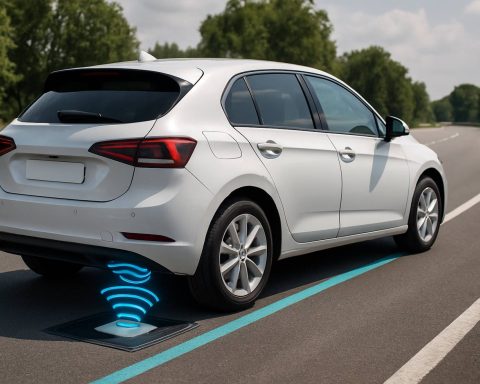- Nio, a Chinese EV leader, is known for its innovative battery-swapping technology, offering quick “refueling” times and cost savings.
- The company faces fierce competition from Tesla, BYD, and Xpeng, amid a rapidly growing EV market projected to exceed 20 million unit sales by 2025.
- Nio enhances its customer experience with Nio Houses, combining luxury lifestyle hubs and cultural spaces.
- Financial challenges persist, as Nio endures a significant net margin slump of -38.02% and carries substantial debt.
- Despite $6 billion in cash reserves, concerns over cash burn and potential shareholder dilution loom.
- New product launches like the ET9 sedan aim to captivate investors, but market competition remains intense.
- Nio must address operational inefficiencies to secure a profitable future and assert its place in the evolving EV market.
An electric future looms large, and Nio finds itself grappling with both promise and peril within this burgeoning market. This Chinese electric vehicle (EV) pioneer, known for its breathtaking speed of innovation, stands at a crossroads—balancing its pioneering battery-swapping technology against the harsh realities of its financial landscape.
In the heart of China’s bustling EV arena, Nio has carved out a niche with its innovative approach to eliminating range anxiety. Picture this: a car “refueling” in mere minutes—about as long as a coffee break—thanks to advanced battery-swapping technology. This not only cuts down charging time substantially but also slashes costs upfront, providing Nio an edge amidst fierce competition with Tesla and other luxury automakers.
Nio is more than just a car company; it strives to envelop customers in an experience. Plush Nio Houses serve as lifestyle hubs, presenting a mélange of cultural events and personal spaces. But shiny showrooms can’t outshine the numbers, which cast a shadow on Nio’s future. Despite a promising portfolio that includes the elegantly designed ET7 sedans and versatile ES6 SUVs, Nio’s financial health reveals a daunting picture.
A deep dive into Nio’s finances reveals a company stuck in the red. Its staggering net margin slump of -38.02% signifies a struggle to transition from vision to viable business. Heavy debts cast further doubt over its ambitions. Even with $6 billion in cash reserves, the company’s cash burn threatens to necessitate further funding—a move that could weaken existing shareholders’ stakes.
As the EV market zips along, projected to cross 20 million unit sales by 2025, Nio dreams big but is constrained by its own operational inefficiencies. While expected new launches like the high-end ET9 sedan and budget-friendly models may spark some investor excitement, these come amid heavy competition from firms like BYD and Xpeng.
Ultimately, the question remains: can Nio shift its gears fast enough to turn a potential slip into a successful leap? As market forces close in, Nio’s fight isn’t just about the next best EV but about securing a profitable place on this electric highway. Investors are left to wonder if a new wave of products can stabilize Nio’s turbulent trajectory or whether the road ahead still holds more bumps. The coming year will reveal if the company can thrive in this electrified era or if it will merely flicker under the intense spotlight of competition.
Navigating Challenges and Opportunities: Can Nio Revolutionize the Electric Vehicle Market While Maintaining Financial Stability?
Introduction
As the electric vehicle (EV) revolution accelerates, Nio finds itself at a critical juncture. This Chinese pioneer in the EV sector has captured attention with its innovative solutions like battery-swapping technology, designed to ease range anxiety and provide quicker “refueling” than traditional charging. Yet, despite its technological advances and lifestyle-centric customer approach, the company faces significant financial hurdles that could impact its future prospects.
Key Facts About Nio’s Current Landscape
– Battery-Swapping Innovation: Nio’s battery-swapping technology stands out by allowing vehicles to swap depleted batteries for charged ones in just a few minutes. This is a stark contrast to conventional charging, which can take hours, offering a practical solution to range anxiety (source: Nio).
– Lifestyle-Centric Marketing: Through Nio Houses, the company promotes not just cars, but a lifestyle, offering cultural events and personal spaces for community engagement.
– Financial Challenges: Nio’s current net margin stands at a daunting -38.02%. This reflects the significant financial strain within its operations, amplified by heavy debts and a concerning rate of cash burn, which threatens to dilute shareholder value with potential future funding rounds.
– Product Portfolio: With models like the ET7 sedan and ES6 SUV, Nio offers a diverse range of vehicles. Future launches like the ET9 and budget-friendly models may help Nio attract a broader customer base.
Addressing Reader Questions
1. How does Nio’s battery-swapping technology compare to traditional charging?
– Traditional charging can take hours, while Nio’s battery-swapping technology accomplishes the task in under five minutes, akin to a quick coffee break.
2. Is Nio financially viable in the long term?
– Immediate concerns revolve around Nio’s financial health, given its high cash burn rate and debt levels. The company needs to enhance operational efficiency and possibly rethink its financial strategies to achieve long-term viability.
3. Where does Nio stand in terms of competition?
– Nio faces stiff competition from Tesla, BYD, and Xpeng, each with their own technological advances and market strategies. Nio’s niche lies in its lifestyle experience and innovative battery technology, which it must leverage effectively.
Industry Trends and Market Forecasts
– EV Market Growth: The global electric vehicle market is expected to exceed 20 million unit sales by 2025. This promising trend highlights the urgency for companies like Nio to solidify their market position to harness this growth effectively.
– Shift Towards Affordability: There’s an increasing demand for affordable EV models, pushing companies to diversify offerings beyond luxury segments to capture a wider customer base.
Pros and Cons of Investing in Nio
– Pros: Nio’s technological edge and unique customer engagement strategy could carve a niche within the luxury EV market. Future models promise to expand its customer base.
– Cons: High financial risks due to negative profit margins and significant debt overshadow its innovative technological advantages.
Actionable Recommendations for Nio
– Enhance Financial Strategy: Nio should focus on reducing cash burn by streamlining operations and cost optimization.
– Diversify Product Line: Launch more budget-oriented models to appeal to a broader audience, leveraging the growth in the overall EV market.
– Leverage Partnerships: Collaborations with technology and financial partners could provide crucial support both in innovation and financial stability.
In conclusion, Nio’s future hinges on the ability to balance innovation with financial sustainability. By addressing these core areas, the company can potentially transform its financial trajectory and remain a formidable player in the rapidly evolving electric vehicle market.








